Korean reunification flag
| Flag | Date | Use | Description |
|---|---|---|---|
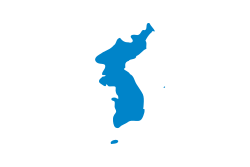 | 1991–present | Korean Unification Flag | Used to represent the whole of Korea when North and South participate together in international sporting events. [1] |
This is a list of flags used by South Korea, North Korea, and their predecessor states.
| Flag | Date | Use | Description |
|---|---|---|---|
 | 1991–present | Korean Unification Flag | Used to represent the whole of Korea when North and South participate together in international sporting events. [1] |
| Flag | Date | Use | Description |
|---|---|---|---|
| Present national flags of North and South Korea | |||
 | 1948–present | | Red field with a blue bar on the top and bottom separated by a thin white stripe, the red field charged near the hoist with a white disc with a red star in the center. Current, post-1992 standard shown. |
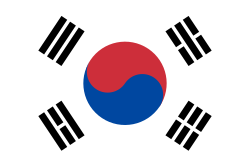 | 1948–present | | White field with a red and blue taegeuk in the center and four black trigrams, one in each corner of the flag. Modified several times since its original adoption in 1948. Current, post-2011 version shown. |
| Historical versions | |||
 | Extant 1392 | | Also known as the "Bong-gi", which means "The Phoenix Flag". |
 | Extant 1392 | | Also known as the "Haema-gi", which means "The Seahorse Flag". |
 | Extant 1392 | | Also known as the "Sang-gi", which means "The Elephant Flag". |
 | Extant 1876 | | |
 | 1882–1907 | | |
 | 1897–1907 | | |
 | 1908–1910 | | |
 | 1908–1910 | | |
 | 1908–1910 | | |
 | 1908–1910 | | |
 | 1908–1910 | | |
 | 1908–1910 | | |
 | 1882–1910 | The first version from top is depicted in the 1882 U.S. Navy book Flags of Maritime Nations. The third version from the top is a replica of the one given by emperor Gojong to American diplomat Owen N. Denny (1838–1900), who served as his advisor. The second version from the bottom is depicted in the 1899 U.S. Navy book Flags of Maritime Nations. Lowest is the version found in the 1944 United States postage stamp series. | The former Korean imperial flag had a different taegeuk from that in the current South Korean flag. Note that the 1882 U.S. Navy depiction may be left-right reversed. The arrangement of the trigrams was not officially fixed until an ordinance of 1949, when the South Korean government issued the construction. |
 | |||
 | |||
 | |||
 | |||
 | |||
 | 1919–1948 | | In exile in several cities of China |
 | |||
 | |||
 | 1945–1946 | | A white rectangular background with three red horizontal strips throughout middle, and a red and blue taegeuk with white border near hoist side. Used by the People's Committees throughout postwar Korea. |
 | 1945–1948 | | A white rectangular background, a red and blue taegeuk in the center that symbolizes harmony, and four black trigrams, on each corner of the flag. |
 | |||
 | 1946–1948 | Flag of the Provisional People's Committee for North Korea | A white rectangular background, a red and blue taegeuk in the center that symbolizes harmony, and four black trigrams, on each corner of the flag. |
 | 1948–1992 | Flag of the Democratic People's Republic of Korea | Red field with a blue bar on the top and bottom separated by a thin white stripe, the red field charged near the hoist with a white disc with a red star in the center. |
 | 15 August 1948 –14 October 1949 | Civil and state flag and ensign of the First Republic of South Korea. | This flag was designed by the first National Assembly. |
 | 15 October 1949 –20 February 1984 | Civil and state flag and ensign of the First, Second, Third, Fourth and the Fifth Republic of South Korea. | The construction sheet was specified by the Ministry of Education and Culture in October 1949. The exact colors were specified via presidential decree in October 1997. [5] [6] |
 | 21 February 1984 –14 October 1997 | Civil and state flag and ensign of the Fifth and Sixth Republic of South Korea. | |
 | 15 October 1997 –29 May 2011 | Civil and state flag and ensign of the Sixth Republic of South Korea. | |
| Flag | Date | Party | Description |
|---|---|---|---|
 | 1935–1947 | | |
 | 1926–? | | Red flag with the abbreviation ㅌ.ㄷ in the middle |
 | 1909–1940s | | Red flag with yellow canton bearing red-blue taegeuk. |
 | 1913–current | | |
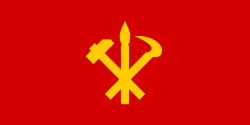 | 1949–present | Flag of the Workers' Party of Korea | Combination of a hammer (workers), a writing brush (intellectuals) and a Korean sickle (peasants), crossed over a red field. |
 | 1946–present | Flag of the Socialist Patriotic Youth League | Emblem of Youth League on a red flag, with "Youth" (청년) on the emblem. |
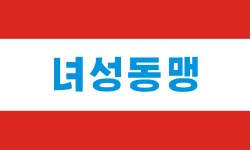 | 1945–present | Flag of the Socialist Women's Union of Korea | Red-white-red flag with the name of the organization: "Women's League" (녀성동맹). |
 | 1955–present | Flag of the Korean Youth League in Japan | Tricolor flag with the League's logo. |
 | 2024–present | Flag of the Democratic Party of Korea | Blue flag with the party emblem in the middle. |
 | 2020–present | Flag of the People Power Party | White flag with the party emblem in the middle. |
 | Red flag with the party emblem in the middle. | ||
 | 2014–present | Flag of the Justice Party | White flag with the party emblem in the middle. |
| Flag | Date | Use | Description |
|---|---|---|---|
| Standard of the President of the State Affairs Commission | |||
 | 2018–present | | Emblem of the President of the State Affairs Commission on a dark red field. |
| Flag of the National Government | |||
 | 2023–present | Flag of the Ministry of National Defence | Red flag with the emblem of the Korean People's Army that defaced with the emblem of North Korea |
 | 2023–present | Flag of the Ministry of Social Security, also flag of the Social Security Forces | Top portion in dark green and a narrow gold stripe, middle in black with two rectangles bearing two black oblique stripes on both hoist and fly, bottom in dark green and a narrow gold stripe, superimposed with the emblem of the ministry. The slogan reads "Protect the political security of the socialist motherland and the happiness of the People!" (사회주의조국의 정치적안전과 인민의 행북을 보위하여) |
 | 2023–present | Flag of the Ministry of State Security | Bicolour of black and gold with 5 alternating stripes between the large stripes and additional black stripe with the emblem of the ministry in the middle. The slogan reads "For the firmly security of the party and the country, and the victory of the great achievement of the Juche Revolution! (당과 국가의 굳건한 안전과 주체혁명위업의 승리를 위하여)" |
| Flag | Date | Use | Description |
|---|---|---|---|
| Presidential standard | |||
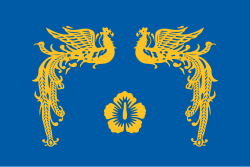 | 1967–present (design update in 2020) | | Two Phoenix taking golden Hibiscus syriacus under their wings. |
| Standard of the prime minister | |||
 | 1988–present | | Golden Hibiscus syriacus inlaid in symbolic Hibiscus syriacus insignia |
| Flag of the National Government | |||
 | 1988–2016 | | Symbolic Hibiscus syriacus insignia, inlaid with the word 정부 ("Government"). |
 | 2016–present | | Symbolic Taeguk insignia, with wordmark in Korean 대한민국정부 ("Government of the Republic of Korea"). |
 | 2005–present | Flag of the South Korean national police agency. | Insignia of the South Korean National Police, with the words 경찰청 ("Police Agency") |
 | 2005–present | Flag of the South Korean coast guard | Insignia of the South Korean coast guard, with the words 해양경찰청 ("Maritime Police Agency") |
 | 2004–present | Flag of the South Korean Supreme Prosecutors' Office | Insignia of the Supreme Prosecutors' Office, with the words 검찰 / Prosecution Service |
 | 2022–present | Flag of the Corruption Investigation Office for High-ranking Officials | Insignia of the Corruption Investigation Office for High-ranking Officials, with the words 고위공직자범죄수사처 ("Corruption Investigation Office for High-ranking Officials") |
| Flag of the Committee for the Five Northern Korean Provinces | |||
 | 1949–2016 | | White flag with a Hibiscus syriacus superimposed by a blue north pointer |
 | 2016–present | | Symbolic Taeguk insignia, with grey words 이북5도위원회 ("Committee for the Five Northern [Korean] Provinces") |
| Flag | Date | Use | Description |
|---|---|---|---|
 | 4th century | | A banner with a simple orange field. |
| | Mid 5th Century | | A black 4-pointed banner with 3 white stripes. |
| | Late 5th Century | | A red swallowtail banner with a yellow stripe. |
 | | A banner with a simple yellow field. | |
 | | A banner with a blue field with a white crescent moon in the center. | |
 | | A banner with Nakseo magic square. | |
 | | As one of the military flags of the Joseon Dynasty, it is called Sujagi (帥字旗) or Sugi (帥旗). During the Joseon Dynasty, it was hung as a mark of the general in the military camp. As for the shape, the word for "command" (帥) is engraved in black letters on the pressed color, and some have a dream (decoration of the flag) around the flag. | |
 | 1930s | | Red field with golden word "Anti-Japanese People's Guerilla Troop" (반일인민유객대). Revived as ceremonial unit color for historical units in North Korea beginning 2015. |
| Flag | Date | Use | Description |
|---|---|---|---|
 | 1996–2002 | | |
 | 2002–2022 [7] | The Supreme Commander Star on a red flag. Sometimes used as a war flag during military exercises. | |
 | 1948 | | Initially designed in 1948 with the early draft for the Emblem of North Korea in 1948. The slogan reads: "For the independence of the motherland and the people" (조국의 독립과 인민을 위하여). Used only as ceremonial unit color for historical units beginning 2013. |
 | With a red star with golden border and bearing a hammer and two sickles. The inspection reads: "Korean People's Army / [Unit number] / 1st (as in ceremonies) Defensive Division" (조선인민군 제1국방사단). Revived as ceremonial unit color for historical units beginning 2015. | ||
 | 1948–1961 | Used only as ceremonial unit color for historical units beginning 2013. | |
 | |||
 | Used for Guards units only. The slogan on obverse side reads: "For the motherland's freedom and independence" (조국의 자유와 독립을 위하여). The reverse side have a Guards badge with Korean letters reading "[Unit number] / Guards Kang Kon 2nd (as in ceremonies) Infantry Division" (근위강건제2부병사단). Revived as ceremonial unit color for Guards units beginning 2013. | ||
 | |||
 | 1961–1992 [8] | Latest version shown; emblem adopted in 1992. [8] The slogan reads: "For the unification and independence of the motherland, and the freedom and happiness of the people" (조국의 통일, 독립과 인민의 자유와 행복을 위하여). | |
 | 1992–1993 | Emblem of DPRK updated to the one featuring the Paektu Mountain. | |
 | 1961–1993 (reverse) | With a red star with golden border and bearing a hammer and two sickles. | |
 | 1993–2023 | Flag of the General Staff of the Korean People's Army | Seen used during the October 1995 parade, observed very rarely. |
 | |||
 | 2023–present | Red flag with the emblem of the KPA is defaced with the emblem of the DPRK emblazoned on largened red star. The slogan reads "For the endless prosperity of the fatherland and the security of the people! (조국의 무궁한 번영과 인민의 안녕을 위하여)", with the date of the founding of the KPA as 2 February 1948 in the canton. | |
 | A design containing the façade of the WPK headquarters in Pyongyang, and a red shield bearing the party symbol. [9] | ||
 | 1993–2023 [10] | | Emblem of KPA with slogan: "For the unification and independence of the motherland, and the freedom and happiness of the people" (조국의 통일, 독립과 인민의 자유와 행복을 위하여). [8] Until the death of Kim Il Sung, version with the slogan "Let us defend the Party's Central Committee headed by dear Comrade Kim Il Sung with our lives!" (경애하는 김일성동지를 수반으로 하는 당중앙위원회를 목숨으로 사수하자!) was also used. When Kim Jong Il was in power, the slogan used between 1997–2011 was: "Let us defend the headquarters of the revolution headed by the great Comrade Kim Jong Il with our lives!" (위대한 김정일동지를 수반으로 하는 혁명의 수뇌부를 목숨으로 사수하자!). Until the flag replacement in 2023, the slogan "Let us defend the Party's Central Committee headed by the great Comrade Kim Jong Un with our lives!" (위대한 김정은동지를 수반으로 하는 당중앙위원회를 목숨으로 사수하자!) was also used. The 4.25 commemorates the foundation of People's Anti-Japanese Guerrilla Army on April 25, 1932. [8] Also used since 2020 by the Special Operations, Strategic Forces and Social Security Forces as branch and unit colours. Continually used as ceremonial unit color for historical units as of 2025. |
 | |||
 | |||
 | |||
 | Reverse side of the flag of the Korean People's Army Ground Force. | With Korean letters reading "Revolutionary armed forces of the Workers' Party of Korea, Korean People's Army [unit name] / No.425 unit (in ceremonies)" (조선로동당의 혁명적무장력인 조선인민군 제425 군부대). The number 425 commemorates the foundation of People's Anti-Japanese Guerrilla Army on April 25, 1932. | |
 | 2023–present | | Identical to the former flag except the emblem of the KPA is defaced with the emblem of the DPRK emblazoned on largened red star. The slogan reads "For the endless prosperity of the fatherland and the security of the people! (조국의 무궁한 번영과 인민의 안녕을 위하여)", with the date of founding of the particular unit placed in the canton. This flag is used by units of the Ground Forces to serve as a unit flag. The date of foundation on the canton differs among KPAGF units of regiment/brigade level and above, independent battalions and educational institutions. |
 | Reverse side of the flag of the Korean People's Army Ground Force. | Identical to the former flag except the party symbol is placed within a design containing the facade of the WPK headquarters in Pyongyang. The slogan reads "Let us defend the Party's Central Committee headed by Dear Comrade Kim Jong Un with our lives!" (경애하는 김정은동지를 수반으로 하는 당중앙위원회를 목숨으로 사수하자!) [9] | |
 | 1993–2023 [10] | | Emblem of KPA with anchor. The slogan reads: "For the unification and independence of the motherland, and the freedom and happiness of the people" (조국의 통일, 독립과 인민의 자유와 행복을 위하여). Until the death of Kim Il Sung, version with the slogan "Let us defend the Party's Central Committee headed by dear Comrade Kim Il Sung with our lives!" (경애하는 김일성동지를 수반으로 하는 당중앙위원회를 목숨으로 사수하자!) was also used. When Kim Jong Il was in power, the slogan used between 1997–2011 was: "Let us defend the headquarters of the revolution headed by the great Comrade Kim Jong Il with our lives!" (위대한 김정일동지를 수반으로 하는 혁명의 수뇌부를 목숨으로 사수하자!). Until the flag replacement in 2023, the slogan "Let us defend the Party's Central Committee headed by the great Comrade Kim Jong Un with our lives!" (위대한 김정은동지를 수반으로 하는 당중앙위원회를 목숨으로 사수하자!) was also used. The 4.25 commemorates the foundation of People's Anti-Japanese Guerrilla Army on April 25, 1932. Continually used as ceremonial unit color for historical units as of 2025. |
 | |||
 | |||
 | |||
 | Reverse side of the flag of the flag of Korean People's Navy. | With Korean letters reading "Revolutionary armed forces of the Workers' Party of Korea, Korean People's Army [unit name] / No.415 unit (in ceremonies)" (조선로동당의 혁명적무장력인 조선인민군 제415 군부대). The number 415 commemorates the birthday of Kim Il-Sung on April 15. | |
 | 2023–present | | Identical to the former flag except the emblem of the KPA is defaced with the emblem of the DPRK emblazoned on largened red star, surrounded by a laurel wreath, and surmounted by an anchor and steering wheel. The slogan reads "For the endless prosperity of the fatherland and the stabling of the people! (조국의 무궁한 번영과 인민의 안녕을 위하여)", with the date of founding of the particular unit placed in the canton. The representative flag of the whole branch displays the date 28 August 1949. |
 | Reverse side of the flag of the flag of Korean People's Navy. | Identical to the former flag except the party symbol is placed within a design containing the façade of the WPK headquarters in Pyongyang. The slogan reads "Let us defend the Party's Central Committee headed by Dear Comrade Kim Jong Un with our lives!" (경애하는 김정은동지를 수반으로 하는 당중앙위원회를 목숨으로 사수하자!) [9] | |
 | 1990s–present | | Red flag with Paektu Mountain in rays in a disc with national color outlines and a red star. |
 | 1990s–present | | |
 | 1990s–present | | |
 | 1993–2023, [10] (insignia updated in 2012) | | Emblem of KPA with wings. The slogan reads: "For the unification and independence of the motherland, and the freedom and happiness of the people" (조국의 통일, 독립과 인민의 자유와 행복을 위하여). Until the death of Kim Il Sung, version with the slogan "Let us defend the Party's Central Committee headed by dear Comrade Kim Il Sung with our lives!" (경애하는 김일성동지를 수반으로 하는 당중앙위원회를 목숨으로 사수하자!) was also used. When Kim Jong Il was in power, the slogan used between 1997–2011 was: "Let us defend the headquarters of the revolution headed by the great Comrade Kim Jong Il with our lives!" (위대한 김정일동지를 수반으로 하는 혁명의 수뇌부를 목숨으로 사수하자!). Until the flag replacement in 2023, the slogan "Let us defend the Party's Central Committee headed by the great Comrade Kim Jong Un with our lives!" (위대한 김정은동지를 수반으로 하는 당중앙위원회를 목숨으로 사수하자!) was also used. The 4.25 commemorates the foundation of People's Anti-Japanese Guerrilla Army on April 25, 1932. Continually used as ceremonial unit color for historical units as of 2025. |
 | |||
 | |||
 | |||
 | 1993–2023 | Reverse side of the flag of the Korean People's Army Air and Anti-Air Force. | With Korean letters reading "Revolutionary armed forces of the Workers' Party of Korea, Korean People's Army [unit name] / No.216 unit (in ceremonies)" (조선로동당의 혁명적무장력인 조선인민군 제216 군부대). The number 216 commemorates the birthday of Kim Jong-Il on February 16. |
 | 2023–present | | Identical to the former flag except the emblem of the KPAAF is defaced with the emblem of the DPRK emblazoned on largened red star with additional stars at the top. Lower stripes are arranged as chevrons, and with six trailing jet fighters emerging behind the emblem. The slogan reads "For the endless prosperity of the fatherland and the security of the people! (조국의 무궁한 번영과 인민의 안녕을 위하여)", with the date of founding of the particular unit placed in the canton. The representative flag of the whole branch displays the date 29 November 1945. |
 | Reverse side of the flag of the Korean People's Army Air Force. | Identical to the former flag except the party symbol is placed within a design containing the façade of the WPK headquarters in Pyongyang. The slogan reads "Let us defend the Party's Central Committee headed by Dear Comrade Kim Jong Un with our lives!" (경애하는 김정은동지를 수반으로 하는 당중앙위원회를 목숨으로 사수하자!) [9] | |
 | 2018–2020 | Flag of the Strategic Force | Emblem of KPA on an upper half globe |
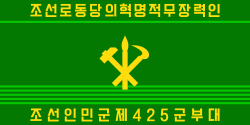 | With Korean letters reading "Revolutionary armed forces of the Workers' Party of Korea, Korean People's Army [unit name] / No.108 unit (in ceremonies)" (조선로동당의 혁명적무장력인 조선인민군 제108 군부대). The number 108 commemorates the birthday of Kim Jong-Un on January 8. | ||
 | 2023–present | With the same pattern as army flag but has the date 3 July 1999 on obverse side. | |
 | |||
 | 2023–present | | The Flag of the Missile Administration is seen with its Emblem in a large form with the founding date of 2016.4.30, The slogan reads "For the defense of the Democratic People's Republic of Korea and the security of its people! (조선민주주의인민공화국의 안전과 인민의 안녕을 위하여)" |
 | Identical to the Backside flags of the KPA except the party symbol is placed within a design containing the façade of the WPK headquarters in Pyongyang | ||
 | 2018–2020 | Flag of the Special Operation Force | Emblem of KPA with the Big Dipper. |
 | With Korean letters reading "Revolutionary armed forces of the Workers' Party of Korea, Korean People's Army [unit name]". / No.506 unit (in ceremonies)" (조선로동당의 혁명적무장력인 조선인민군 제506 군부대). The number 506 commemorates the 7th Congress of the Workers' Party of Korea on May 6, 2016. | ||
 | 2023–Present | With the same pattern as army flag but has the date 7 February 1969 on obverse side. | |
 | |||
 | 2007–2023 | Flag of the Worker-Peasant Red Guards | Slogan used until 2012, since then the flag shares the same motto as the rest of the KPA. |
 | With Korean letters reading "Worker-Peasant Red Guards". | ||
 | 2023–Present | The slogan reads "For the endless prosperity of the fatherland and the security of the people! (조국의 무궁한 번영과 인민의 안녕을 위하여)" | |
 | With Korean letters reading "Worker-Peasant Red Guards". |
| Flag | Date | Use | Description |
|---|---|---|---|
 | 1948–present | | Insignia of the armed forces on a red field. |
 | ?–present | | Insignia of the armed forces and four stars on a red field. |
 | ?–present | | Insignia of the armed forces and four stars on a blue field. |
 | ?–present | | Crimson flag with the insignia of the JCS and the words 합동참모본부. |
 | ?–present | | Insignia of the Chairman of the Joint Chiefs of Staff on a crimson field. |
 | 1946–present | | Insignia of the army on a field parted per fess; above is white, below is blue. |
 | ?–present | | Insignia of the Chief of Staff and four stars on a red field. |
 | ?–present | | Four stars and a Hibiscus syriacus on a red field. |
 | ?–present | | Three stars and a Hibiscus syriacus on a red field. |
 | ?–present | | Two stars and a Hibiscus syriacus on a red field. |
 | ?–present | | A star and a Hibiscus syriacus on a red field. |
 | 1955–present | Naval ensign, navy flag, and naval jack | Taegeuk on crossed anchors in a white canton on a blue field |
 | ?–present | | Insignia of the Chief of Naval Operations and four stars on a blue field |
 | ?–present | | Four stars and a Hibiscus syriacus on a blue field. |
 | ?–present | | Three stars and a Hibiscus syriacus on a blue field. |
 | ?–present | | Two stars and a Hibiscus syriacus on a blue field. |
 | ?–present | | A star and a Hibiscus syriacus on a blue field. |
 | 1952–present | | The similarity with the flag of the United States Marine Corps shows the strong influence of the United States since the creation of South Korean armed forces. |
 | ?–present | | Three stars above the insignia of the Marine Corps on a red field. |
 | ?–present | | Three stars and a Hibiscus syriacus on a red field. |
 | ?–present | | Two stars and a Hibiscus syriacus on a red field. |
 | ?–present | | A star and a Hibiscus syriacus on a red field. |
 | 1952–present | | Insignia of the air force on a sky blue field. |
 | ?–present | | Insignia of the Chief of Staff and four stars on a sky blue field. |
 | ?–present | | Four stars and a Hibiscus syriacus on a sky blue field. |
 | ?–present | | Three stars and a Hibiscus syriacus on a sky blue field. |
 | ?–present | | Two stars and a Hibiscus syriacus on a sky blue field. |
 | ?–present | | A star and a Hibiscus syriacus on a sky blue field. |
 | 1968–present | Flag of the Republic of Korea Reserve Forces | Insignia of the Reserve Forces on a blue field. |
By forbearing to march behind the yin-yang flag at the opening ceremony of the Olympics, the South Korean athletes are making a bigger sacrifice than the North Koreans... [T]he peninsula flag means two very different things to the two Koreas. In the South it symbolizes a desire for peaceful co-existence, or at most for a unification of equal partners in the reassuringly remote future. In wall posters above the DMZ it has always symbolized the southern masses' yearning for "autonomous unification", meaning absorption by the North. It's worrying to think how inner-track propaganda is certain to misrepresent the South Koreans' eschewal of their state flag for this of all symbols — and at this of all events.